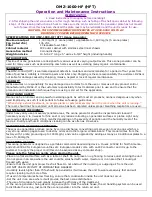
5566020-JIM-C-1019
60
Johnson Controls Ducted Systems
Retry operation
When a flame is lost or is not detected during an attempt to
achieve ignition, a retry operation occurs. A 30-second purge is
performed between ignition attempts.
If the unit fails after three ignition attempts, the furnace is locked
out for one hour. The furnace is monitored during this one-hour
period for unsafe conditions.
Recycle operation
When a flame is lost after the flame stabilization period, a recy-
cle operation occurs. If the unit fails after five recycle attempts,
the furnace is locked out for one hour.
Gas heating operation errors
Lockout
A one-hour lockout occurs following three retries or five
recycles. During the one-hour lockout, flame detection, limit
conditions, and main valves are tested. Any improper results
will cause the appropriate action to occur. Recycling the low
voltage power cancels the lockout.
Temperature limit
If the UCB senses zero volts from the high temperature limit,
the indoor blower motor is immediately energized. When the
UCB again senses 24 volts from the temperature limit, the draft
motor performs a 15-second post-purge and the indoor blower
is de-energized following the elapse of the fan off delay for
heating.
This limit is monitored regardless of unit operation status, that
is, this limit is monitored at all times.
If the temperature limit opens three times within one hour, it
locks on the indoor blower motor.
Flame sense
Flame sensing occurs at all times. If W1 is not present and a
flame is sensed for 2 seconds, the draft motor is energized and
the GV is kept off. The ICB halts any operation until a flame is
not detected. Once the flame detection is lost, the ICB performs
a post-purge. Normal operation is allowed concurrently with the
purge. That is, this purge can be considered the purge
associated with a call for W1.
If W1 is present, a flame is sensed but the GV is not energized
and the draft motor is energized until the flame detection is lost.
Normal operation is now allowed.
The flame detection circuitry continually tests itself. If the ICB
finds the flame detection circuitry to be faulty, the ICB does not
permit an ignition sequence and the draft motor is energized. If
this failure occurs during an ignition cycle, the failure is counted
as a recycle.
Gas valve
The UCB and ICB continuously monitor the GV.
If the ICB senses voltage at the GV when not requested, the
ICB energizes the draft motor. The ICB does not operate the
furnace until voltage is no longer sensed at the GV. The draft
motor is stopped when voltage is not sensed at the GV.
Any time the UCB senses voltage at the GV without a call for
heat for a continuous five-minute period, the UCB locks on the
indoor blower. When voltage is no longer sensed at the GV, the
UCB de-energizes the indoor blower following the elapse of the
fan off delay for heating.
If voltage is sensed at the GV for at least 15 seconds during the
fan on delay for heating and GV voltage or W1 is lost, the
indoor blower is forced on for the length of the fan off delay for
heating.
During a call for heat, if the UCB does not sense voltage at the
GV for a continuous five-minute period, the UCB initiates a error
message. The indoor blower motor is not locked on while there
is no GV voltage.
Safety controls
The UCB monitors the temperature limit switch of gas heat
units.
The control circuit includes the following safety controls:
Limit switch
The limit switch (LS) is located inside the gas heat compartment
and is set to open at the temperature indicated in Table 14. It
resets automatically. The limit switch operates when a high
temperature condition, caused by inadequate supply air flow
occurs. This shuts down the heater and energizes the blower.
Auxiliary limit switch
The auxiliary limit switch (ALS) is wired in series with the limit
switch. As such, the UCB cannot distinguish the auxiliary limit
and the gas heat limit switch operation except the auxiliary is
manual reset. Consequently, the control responds in the same
manner as outlined in
.
The ICB monitors the pressure and roll out switches of gas heat
units.
















































